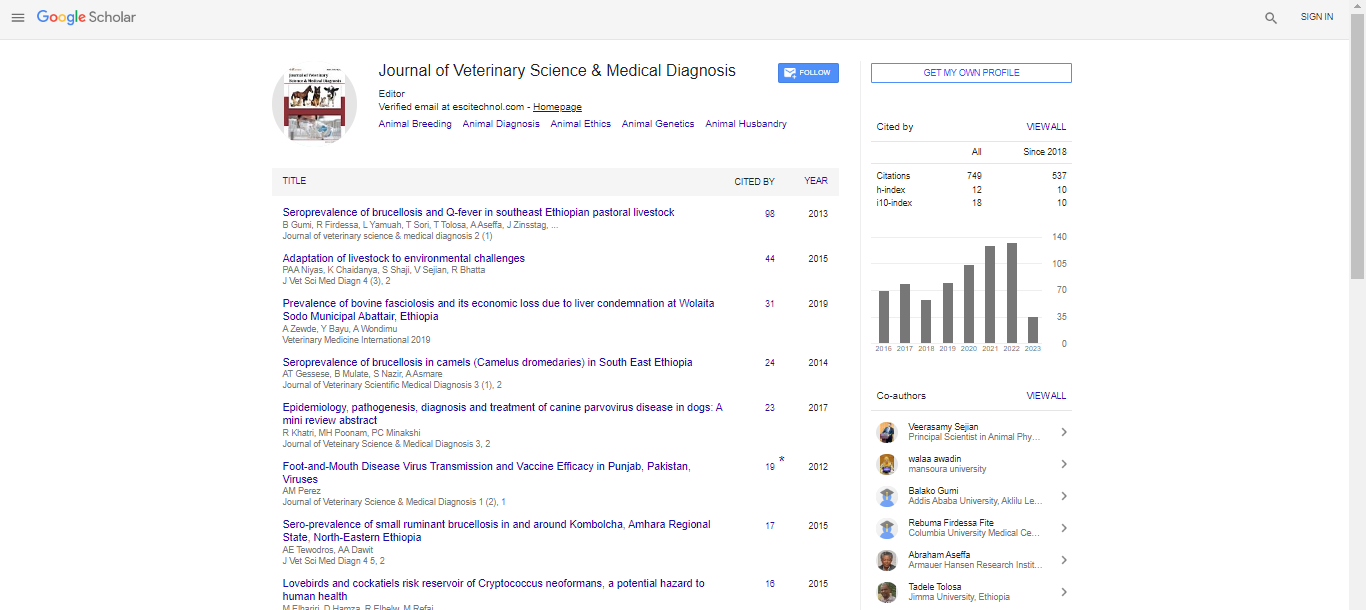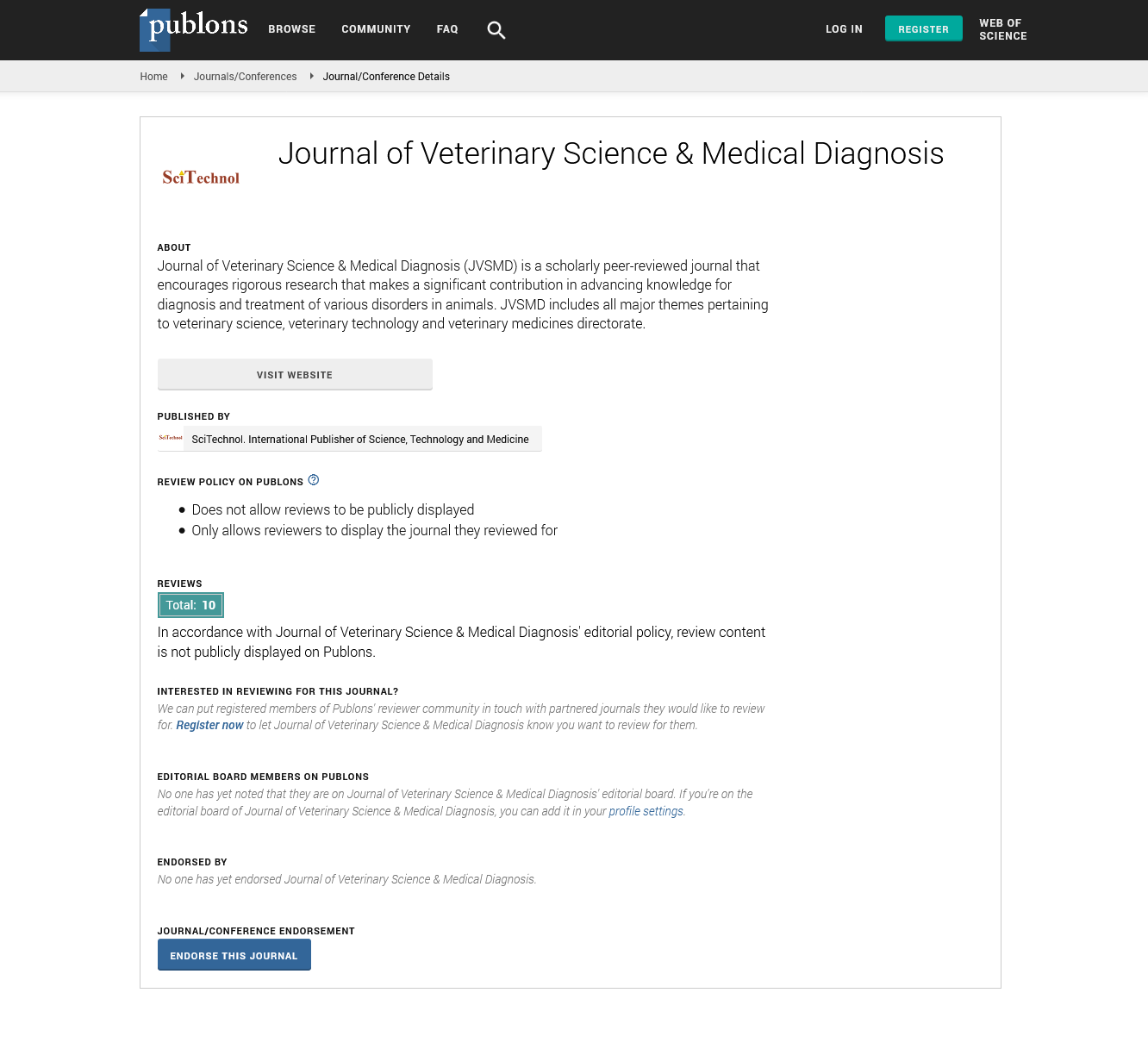Opinion Article, J Vet Sci Med Diagn Vol: 12 Issue: 1
Innovative Technology Implementation in Animal Husbandry
Dirk Pfeiffer*
Department of Veterinary Science, Massey University, Palmerston North, New Zealand
*Corresponding Author: Dirk Pfeiffer
Department of Veterinary Science, Massey University, Palmerston North, New Zealand
E-mail: hjalmar@sant.se
Received date: 02 January, 2023, Manuscript No. JVSMD-23-95342;
Editor assigned date: 04 January, 2023, Pre QC No. JVSMD-23-95342(PQ);
Reviewed date: 18 January, 2023, QC No. JVSMD-23-95342;
Revised date: 27 January, 2023, Manuscript No: JVSMD-23-95342(R);
Published date: 03 February, 2023, DOI: 10.35248/2325-9590.23.12.100041.
Citation: Pfeiffer D (2023) Innovative Technology Implementation in Animal Husbandry. J Vet Sci Med Diagn 12:1.
Description
Animal husbandry, the science of breeding and caring for domesticated animals, has evolved significantly over the years. With the world's population expected to reach 10 billion by 2050, the demand for animal products such as meat, milk, and eggs is on the rise. To meet this growing demand, the animal husbandry industry is embracing emerging trends and technologies that promote animal welfare, sustainability, and efficiency.
One of the emerging trends in animal husbandry is Precision Livestock Farming (PLF), which involves using technology to monitor and manage individual animals' health, productivity, and welfare. PLF technologies include sensors, cameras, and software that collect data on an animal's behavior, movement, feed intake, and health status. This data can then be analyzed to identify patterns and make informed decisions about animal management, such as adjusting feed rations or administering medication. PLF can improve animal welfare by detecting and treating health issues early and reducing stress-inducing management practices.
Another trend in animal husbandry is the use of genomics to enhance animal breeding. Genomics involves analyzing an animal's genetic information to identify desirable traits such as disease resistance, growth rate, and milk production. By selecting animals with these desirable traits, breeders can produce a more productive and profitable herd. Genomics also enables breeders to identify animals that are genetically predisposed to certain diseases, reducing the risk of illness and improving animal health.
Advances in reproductive technologies are also changing the animal husbandry industry. Artificial Insemination (AI) and Embryo Transfer (ET) have been used for decades to improve breeding efficiency, but new technologies are now available that can enhance these techniques further. For example, in vitro fertilization (IVF) allows breeders for produce a multiple embryos from a single donor animal, increasing the number of offspring with desirable traits. Cloning, although controversial, can produce animals with identical genetic material to highly productive animals, ensuring that their desirable traits are passed on to future generations.
The use of big data analytics is also becoming increasingly prevalent in animal husbandry. By analyzing large datasets on animal performance, breeding, and health, breeders can identify trends and patterns that were previously impossible to detect. This can inform management decisions and enhance breeding programs, leading to more productive and profitable animals.
Sustainability is a growing concern in the animal husbandry industry, and emerging technologies are helping to address this issue. For example, researchers are investigating the use of insect protein as a sustainable alternative to traditional animal feed. Insects are highly nutritious and can be produced on a large scale using minimal resources. Other sustainability-focused innovations include the use of renewable energy sources to power farms, the development of biodegradable animal feed packaging, and the implementation of circular farming practices that reduce waste and promote resource efficiency.
The use of robotics and automation is also changing the animal husbandry industry. Robots can be used for tasks such as milking, feeding, and cleaning, reducing the need for manual labor and improving efficiency. Automation technologies can also be used to monitor animal behavior and health, freeing up time for farmers to focus on other aspects of animal management.
Finally, the use of blockchain technology is also becoming increasingly popular in animal husbandry. Blockchain is a secure and transparent ledger that can be used to track and verify information about an animal's breeding history, health status, and product quality. This can improve transparency and trust in the industry, allowing consumers to make more informed decisions about the animal products they consume.
In conclusion, emerging trends and technologies are revolutionizing the animal husbandry industry, with a focus on animal welfare, sustainability, and efficiency. Precision livestock farming, genomics, reproductive technologies, big data analytics, sustainability-focused innovations, robotics and automation, and blockchain technology are all examples of innovations that are driving the industry forward. As the demand for animal products continues.
 Spanish
Spanish  Chinese
Chinese  Russian
Russian  German
German  French
French  Japanese
Japanese  Portuguese
Portuguese  Hindi
Hindi 
